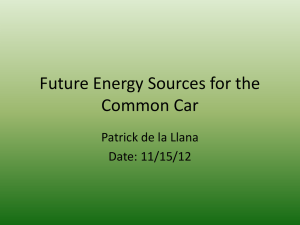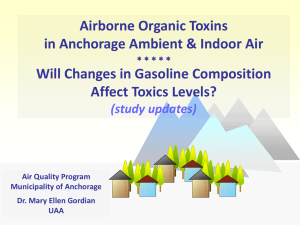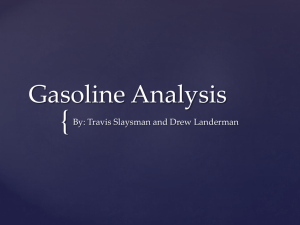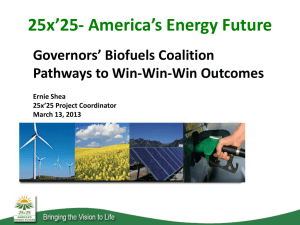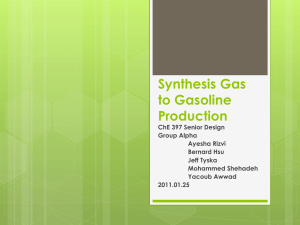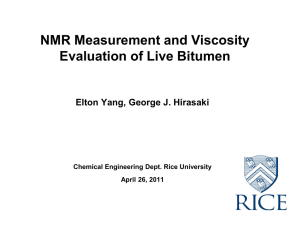Crude Oil - Prafis Energy Solutions
advertisement
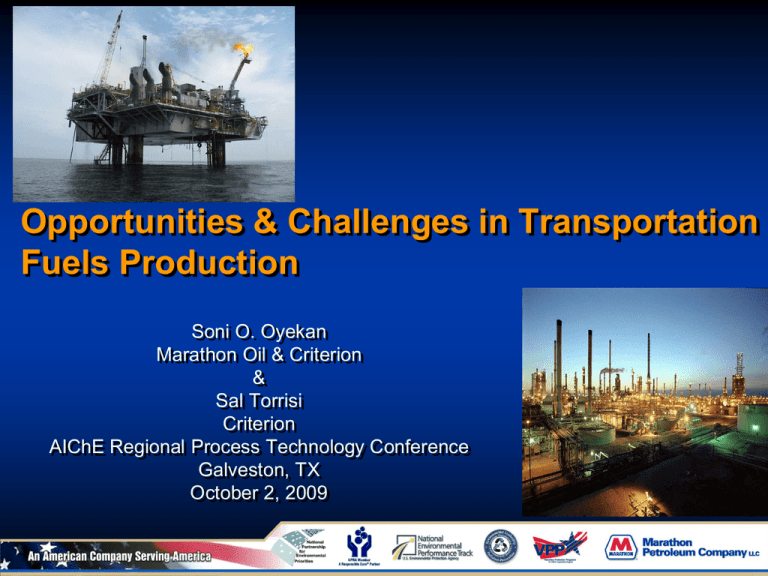
Opportunities & Challenges in Transportation Fuels Production Soni O. Oyekan Marathon Oil & Criterion & Sal Torrisi Criterion AIChE Regional Process Technology Conference Galveston, TX October 2, 2009 Outline • Crude Oil & Bitumen – Availability – Upgrading and refining • Gasoline – Low sulfur gasoline – Ethanol blending – Gasoline benzene • Diesel – ULSD – Biodiesel US Energy Long Term Challenges • Conventional Crude oil – Crude oil quality is declining – Increased competition – China & India – Oil companies and national oil suppliers relationships are evolving – Supply disruptions are more frequent • Crude oil consumption is expected to increase • Greenhouse gas emissions and climate issues are ratcheting up Global Oil Reserves By Country (Source: CAPP) Ref: Emerging technologies for producing paraffins, olefins & aromatics, Michael C. Oballa & Vasily Simanzhenkov Bitumen Provides Options Oils Sands: A mixture of sand, crude bitumen, water and clay Typical Composition 10% bitumen 83% sand 7 % water & clay 1 barrel of bitumen is obtainable from 3 to 4 tons of oil sands! Bitumen is an extra heavy, sour, poor quality oil Significant upgrading required 10 % higher GHG generated relative to conventional oil? Non Facile Commercial Recovery Technologies Surface Mining Ref: Steam Assisted Recovery Bitumen Pose Significant Challenges • • • • • • Bitumen and fractions have higher contaminants – Sulfur distributions reflect more refractory compounds – Higher refractory nitrogen – Higher TAN (Athabasca 3.5 relative to < 1 for conventional oils) Significantly higher hydrogen consumption Natural gas dependency for fuel and hydrogen High requirement for naphtha Pipeline infrastructure for market accessibility Environmental issues – Land reclamation – Sour gases and GHG – Water conservation Plant flexibility and operating margins could be impacted. Bitumen Refining Challenges Oil Type Arab Mars Maya Hamaca Athabasca Med(1) Bitumen(2) Bitumen(3) Gravity, API 30.7 28.1 20.9 8.4 7.5 Sulfur, wt. % 2.4 2.2 3.4 3.8 4.8 TAN, mg/g 0.25 0.63 0.32 2.8 3.5 Ni, wppm 4 20 52 115 150 V, wppm 18 46 232 388 290 1. 2. 3. Marathon crude oil assay database V/Ni ratio a parameter for palaeo-environmental characteristics…., F. Galarraga, et.al., J. Petro. Science, 61, Issue 1, pages 9-14, April 2008 Tutorial on upgrading oil sands bitumen, M. R. Gray, University of Alberta. A Typical Bitumen Upgrader off gases Diluent Recycled Bitumen Naphtha-Jet Atmospheric Distillation Unit N-J HDT SCO Distillates SCO to Refinery Distillate HDT Diluent LVGO Vacuum Distillation Unit VGO HDT HVGO Vacuum Residue Vacuum Gas Oil to Refinery A Simplified Refinery Flow Diagram Penex LSR H/T Atm Unit LPG, C3= Hydrogen Catalytic Reformer NHT Gasoline Blending FCCU Vac Unit DHT H/C Coker Unit Distillate Fuels GDU Coke Asphalt Crack Spread Declining 2009 Market Indicators Are Lower 2008 2Q 2009 2Q Chicago LLS 6-3-2-1($/BBL) 2.71 5.73 Sweet/Sour Diff., ($/BBL) 13.74 3.98 NYMEX WTI ($/BBL) 123.80 59.80 US Refiners Produce Low Sulfur Gasoline • 2006 gasoline sulfur regulation of < 30 wppm S – US refiners met regulation using a variety of technologies and hydrotreating catalysts • Optimized gasoline desulfurization to preserve octane • Technologies used included – – – – Axens Prime G CD Tech ConocoPhillips Szorb ExxonMobil Scanfining • Pool gasoline octane losses of 1 to 3 numbers Ethanol Blending & Naphtha Reforming • US goal is 35 billion gallons per year of ethanol in gasoline by 2022 • E10 gasoline lead to – Increased gasoline volume – – – – Gasoline octane giveaway Low severity reformer operations Lower hydrogen production Inefficient catalytic reformer productivity • Maximize gasoline octane barrels and hydrogen • Energy savings negligible relative to losses of H2 and reformate • Key benefits are less utilization of crude oil for gasoline and enhanced environmental quality US EPA Gasoline Benzene Regulation • US EPA Mobile Source Air Toxics II (MSAT II) regulations effective Jan 2011 – Annual corporate average gasoline pool benzene of 0.62 vol. % – Credits and trade arrangements possible – By July 2012, maximum refinery average gasoline benzene of 1.3 vol. % • Catalytic Reformers produce over 80 % of gasoline benzene • Naphtha Pre-fractionation and Post-fractionation • Pre-fractionation employs naphtha split to reduce benzene and precursors to the reformer – Naphtha Splitter at the crude unit or after NHT – Benzene and precursors converted via Bensat and C5/C6 isomerization – Achieved ~ 35 to 50 % drop in gasoline benzene at two Marathon refineries • Gasoline benzene credits option US EPA Gasoline Benzene Regulation • Post-fractionation and gasoline benzene minimization processes – Extractive distillation for benzene • UOP, Uhde • Reduced gasoline volume • Octane impact – Benzene saturation • Axens, UOP • Gasoline volume maintained • Impact on Octane & H2 consumption – Benzene alkylation to cumene • Capital intensive processes for reducing gasoline benzene and maximizing hydrogen production N. American Clean Diesel Growth Through 2018 <15 PPM 500 PPM 6000 5000 4000 3000 2000 1000 0 2004 2006 2008 2010 2012 2014 2016 2018 Source: Hart World Refining & Fuels Service 17 Oil Refiners Met ULSD Regulation • Technology and oil refining companies honed in on refractory sulfur compounds including 4,6 DM DBT S H3C CH3 • Utilized a combination of new hydrotreating catalysts, increased reactor volumes, reactor internals process modifications Grassroots Units (~15%) Unit Revamps (~75%) No modifications (~10%) • Oil refiners achieved < 10 wppm sulfur to meet pipeline requirements Renewable Diesel Fuels Information • The mandate for annual renewable fuels use is 36 billion gallons of biofuels by 2022 • Biodiesel is a renewable fuel for diesel engines – – – – from natural oils -- soybean oil via reaction with methanol comprised of mono-alkyl esters of long fatty acids meets specifications of ASTM D67511 pure biodiesel is B100 • Biodiesel blend is a blend of biodiesel fuel with petroleum based diesel fuel – BXX, where XX represents percentage of biodiesel – B2, B5 and B20 are used Ref: Biodiesel Technical Information, ADM Biodiesel Technical Services US Biodiesel Production On the Rise • B20 emissions are lower than conventional diesel – – – – – 21 % lower HCs 11 % lower CO 20 % lower PMs ~ 5 % + NOx 20 % lower PAH US Biodiesel Production 700 600 500 400 MM Gals. 300 200 Ref: Clean Cities Fact Sheet US DOE Apr. 2008 100 0 2005 2007 Biofuels Use Will Increase Substantially 16% Source: Hart World Refining & Fuels Service 14% 12% 10% 8% 6% 4% 2% 0% Latin America North America 2006 Europe Asia 2025 21 Summary • Unconventional oils will have a significant impact on US refining plants reliability and profitability • Cost of meeting environmental regulations and GHG re bitumen production will be a factor • Ethanol gasoline and benzene will challenge US refiners • Diesel growth is expected worldwide relative to gasoline • Biofuels use would increase significantly in the next 15 years The Future -- Gas to Liquids ? Upgraded Bitumen Still Challenging Oil Type Arab Maya WCS(4) Athabasca Muskeg R. Med(1) Bitumen(3) Bitumen(3) Gravity, API 30.7 20.9 19.7 7.5 11.2 Sulfur, wt. % 2.4 3.4 3.2 4.8 4.6 TAN, mg/g 0.25 0.32 1.0 3.5 2.9 Ni, wppm 4 52 52 150 58 V, wppm 18 232 122 290 151 1. 2. 3. 4. Marathon crude oil assay database V/Ni ratio a parameter for palaeo-environmental characteristics…., F. Galarraga, et.al., J. Petro. Science, 61, Issue 1, pages 9-14, April 2008 Tutorial on upgrading oil sands bitumen, M. R. Gray, University of Alberta. WCS is Western Canadian Select

